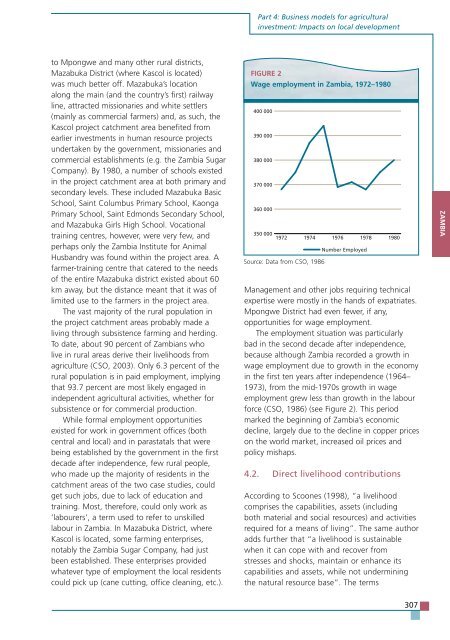TRENDS AND IMPACTS OF FOREIGN INVESTMENT IN DEVELOPING COUNTRY AGRICULTURE
TRENDS AND IMPACTS OF FOREIGN INVESTMENT IN DEVELOPING COUNTRY AGRICULTURE
TRENDS AND IMPACTS OF FOREIGN INVESTMENT IN DEVELOPING COUNTRY AGRICULTURE
Create successful ePaper yourself
Turn your PDF publications into a flip-book with our unique Google optimized e-Paper software.
to Mpongwe and many other rural districts,<br />
Mazabuka District (where Kascol is located)<br />
was much better off. Mazabuka’s location<br />
along the main (and the country’s first) railway<br />
line, attracted missionaries and white settlers<br />
(mainly as commercial farmers) and, as such, the<br />
Kascol project catchment area benefited from<br />
earlier investments in human resource projects<br />
undertaken by the government, missionaries and<br />
commercial establishments (e.g. the Zambia Sugar<br />
Company). By 1980, a number of schools existed<br />
in the project catchment area at both primary and<br />
secondary levels. These included Mazabuka Basic<br />
School, Saint Columbus Primary School, Kaonga<br />
Primary School, Saint Edmonds Secondary School,<br />
and Mazabuka Girls High School. Vocational<br />
training centres, however, were very few, and<br />
perhaps only the Zambia Institute for Animal<br />
Husbandry was found within the project area. A<br />
farmer-training centre that catered to the needs<br />
of the entire Mazabuka district existed about 60<br />
km away, but the distance meant that it was of<br />
limited use to the farmers in the project area.<br />
The vast majority of the rural population in<br />
the project catchment areas probably made a<br />
living through subsistence farming and herding.<br />
To date, about 90 percent of Zambians who<br />
live in rural areas derive their livelihoods from<br />
agriculture (CSO, 2003). Only 6.3 percent of the<br />
rural population is in paid employment, implying<br />
that 93.7 percent are most likely engaged in<br />
independent agricultural activities, whether for<br />
subsistence or for commercial production.<br />
While formal employment opportunities<br />
existed for work in government offices (both<br />
central and local) and in parastatals that were<br />
being established by the government in the first<br />
decade after independence, few rural people,<br />
who made up the majority of residents in the<br />
catchment areas of the two case studies, could<br />
get such jobs, due to lack of education and<br />
training. Most, therefore, could only work as<br />
‘labourers’, a term used to refer to unskilled<br />
labour in Zambia. In Mazabuka District, where<br />
Kascol is located, some farming enterprises,<br />
notably the Zambia Sugar Company, had just<br />
been established. These enterprises provided<br />
whatever type of employment the local residents<br />
could pick up (cane cutting, office cleaning, etc.).<br />
Part 4: Business models for agricultural<br />
investment: Impacts on local development<br />
FIGURE 2<br />
Wage employment in Zambia, 1972–1980<br />
400 000<br />
390 000<br />
380 000<br />
370 000<br />
360 000<br />
350 000<br />
1972<br />
1974<br />
Source: Data from CSO, 1986<br />
1976<br />
1978<br />
Number Employed<br />
1980<br />
Management and other jobs requiring technical<br />
expertise were mostly in the hands of expatriates.<br />
Mpongwe District had even fewer, if any,<br />
opportunities for wage employment.<br />
The employment situation was particularly<br />
bad in the second decade after independence,<br />
because although Zambia recorded a growth in<br />
wage employment due to growth in the economy<br />
in the first ten years after independence (1964–<br />
1973), from the mid-1970s growth in wage<br />
employment grew less than growth in the labour<br />
force (CSO, 1986) (see Figure 2). This period<br />
marked the beginning of Zambia’s economic<br />
decline, largely due to the decline in copper prices<br />
on the world market, increased oil prices and<br />
policy mishaps.<br />
4.2. Direct livelihood contributions<br />
According to Scoones (1998), “a livelihood<br />
comprises the capabilities, assets (including<br />
both material and social resources) and activities<br />
required for a means of living”. The same author<br />
adds further that “a livelihood is sustainable<br />
when it can cope with and recover from<br />
stresses and shocks, maintain or enhance its<br />
capabilities and assets, while not undermining<br />
the natural resource base”. The terms<br />
307<br />
ZAMBIA


